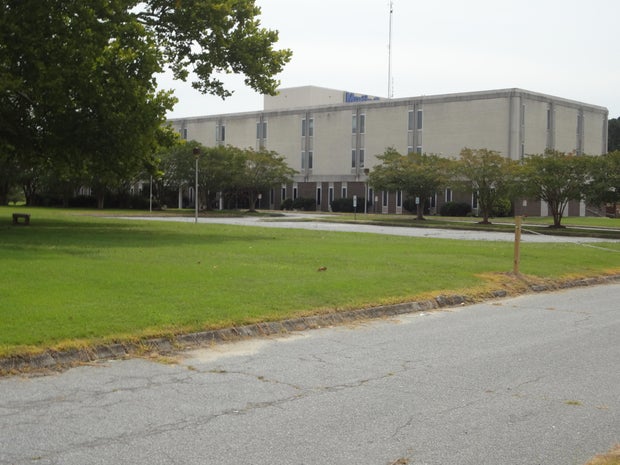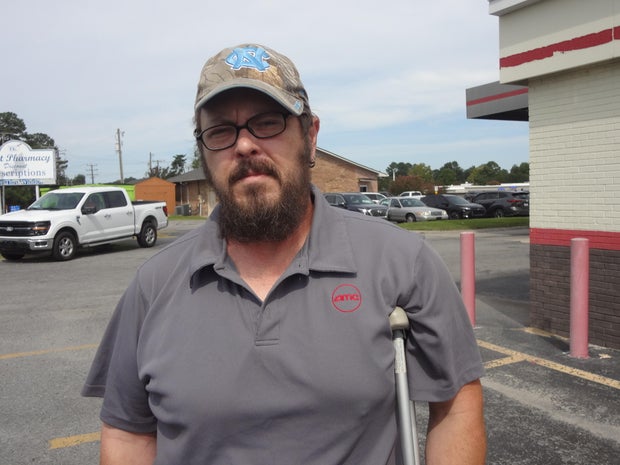Williamston, North Carolina —On a mid-August morning, Christopher Harrison stood outside the closed Martin General Hospital and thought back to the day a year earlier when he took photos as workers covered the hospital sign.
“Yes, sir. It was a sad day,” Harrison said of the financial collapse of the small country hospital where all four of his children were born.
Quorum Health operated the 49-bed facility in this rural eastern North Carolina town of about 5,000 until it closed. hospital had suffered losses for some time. The county’s population has declined slightly and is aging; it has faced increasing economic downturns. As with many rural hospitals, those headwinds have driven managers to termination of labor and delivery services and have discontinued intensive care over the past five years.
The prospects for reopening seemed bleak.
Taylor Sisk for KFF Health News
But a new hospital designation from the Centers for Medicare & Medicaid Services that went into effect last year offered hope. Since August, hospitals in 32 communities across the country have switched to the national emergency department hospital designation to avoid closure. The new program offers a federal financial boost to struggling hospitals that continue to offer emergency and outpatient services but cut inpatient care.
The REH model “is not designed to replace existing, well-functioning rural hospitals,” said George Pink, a senior research scientist at the University of North Carolina’s Cecil G. Sheps Center for Health Services Research, which has documented 149 rural hospitals that have closed or are no longer providing inpatient care since 2010. “It’s really targeted at small rural communities that are at risk of having a hospital close.”
The program has not yet been used to reopen a closed hospital.
With guidance from health advisers, Martin County officials asked federal regulators to investigate the possibility of implementing the REH model. They eventually got the green light.
If successful, Martin County could become one of the first in the country to convert a closed hospital to this new model.
Ask community members who have lost their hospitals what they miss most, Pink said, and it’s almost always the first responders. Count Harrison among them, especially after a medical crisis nearly cost him his life.
Harrison, who lives in a smaller crossroads community a few miles south of Williamston, began experiencing leg pain in February. Under normal circumstances, Harrison said, he would have gone to his family doctor when his leg started hurting. This time, he couldn’t, because the practice closed when the hospital went bankrupt months earlier.
Taylor Sisk for KFF Health News
Then one morning he woke up to find his foot turning black. It took him 45 minutes to drive to the nearest hospital, in Washington City. There, doctors found blood clots and he was flown by helicopter to East Carolina University Health Medical Center. A doctor there told him that he had likely been suffering from the blood clots for almost a year and that he was lucky to be alive. The medical team was able to save his foot from amputation.
Harrison, like many in the community, was now dealing with the consequences of a closed hospital firsthand.
The state legislature’s decision last year to expand Medicaid has resulted in fewer uninsured North Carolinians, meaning fewer hospital bills go unpaid. But health care is evolving: Many procedures that once required inpatient care are now performed as outpatient services. Dawn Carter, the founder and senior partner of Ascendient, a health care consulting firm that works with the county, said Martin General’s patient count has ranged in recent years from five or six a day to a dozen.
“So it’s a high cost and a high infrastructure to support that,” she said.
With no emergency care within a half-hour radius, Martin County administrators believe a rural emergency hospital would be a viable option. REH status allows a hospital to collect enhanced Medicare payments, an annual facility fee, and technical assistance.
Carter said the team will submit some drawings of the portion of the building they plan to use to the Department of Health and Human Services to see if it meets REH regulations.
“I hope that process happens over the next few weeks,” she said, “and that will give us a better idea of whether we need to do some quick and easy things or whether it’s going to take more effort to reopen.”
Officials will then receive proposals from companies interested in running the hospital.
Carter said the facility is expected to initially consist of just an emergency department and imaging. “But then the question is, where do you build over time?”
And rebuilding could be challenging from the start. Many former staff have taken positions at nearby health care facilities or have left the area. The effects of that exodus are compounded by the widespread difficulty of recruiting health care workers to rural areas.
It’s too early to judge the success of the rural emergency hospital model, Pink said. “All we have are anecdotes from behind the couch.” It seems to work well in some communities, while others “are struggling a little bit to make it work.”
Pink has developed a list of questions to help assess how an emergency hospital is doing over the long term:
Is it at least breaking even? And if not, do the administrators provide a solution?
How does the community respond? If someone thinks they have a problem that requires hospitalization, Pink suggested, they might bypass the REH for a hospital that can take them. And to what extent does bypassing their doors apply to all services?
Are patients satisfied with the care they receive? Are clinical outcomes good?
Rural hospital closures rose in 2020 and then fell significantly in 2021. Congress had passed the CARES Act and the Provider Relief Fund provided a financial lifeline, Pink said. That money has now been distributed and the concern is that “many rural hospitals are going to return to the financial stress and unprofitability they were in before COVID.”
If this trend continues, he says, more rural hospitals will switch to the REH model.
Ben Eisner, an attorney and interim executive for Martin County, recognizes that the health and well-being of this community requires much more than a hospital. He cites, for example, a new nonprofit organization with a mission to address the social determinants of health.
Advancing Community Health Together was founded in response to the closure of the hospitalIt is made up of community members and focuses on addressing inadequate access to health care and poor health outcomes resulting from generational poverty, said Vickey Manning, director of Martin-Tyrrell-Washington District Health.
“We can’t do rural health care in a vacuum,” said Carter. Her organization, Ascendient, is part of the Rural Healthcare Initiative, a nonprofit appointed by the North Carolina General Assembly to study sustainable models of health care for rural communities.
Like much of rural eastern North Carolina, Martin County is in transition, Eisner said. Declining family farms, less industry. “And so the question becomes,” he said, “‘What happens to all these communities? What happens next?’ And it’s an answer that hasn’t been fully written yet.”
Harrison, who still relies on crutches to get around, recently drove 45 minutes north on U.S. 13 to the town of Ahoskie to have a doctor examine his foot. He said a hospital that provides basic care isn’t a perfect solution, but he’ll have some peace of mind once the sign’s cover is removed and his local hospital reopens.
KFF Health News is a national newsroom that produces in-depth journalism on health issues and is one of the main operational programs of KFF — the independent source for health policy research, polling and journalism.






